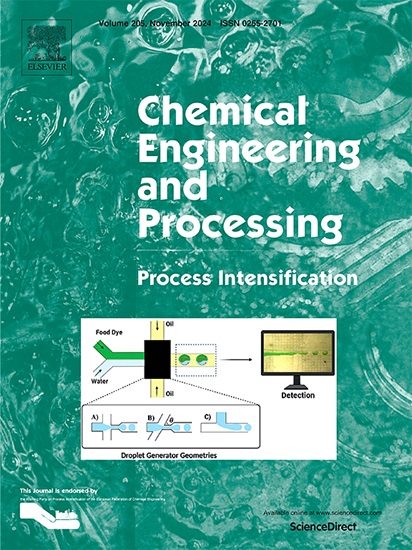Exploring the potential of cashew nut shell biochar for chlorpyrifos pesticide removal
IF 3.8
3区 工程技术
Q3 ENERGY & FUELS
Chemical Engineering and Processing - Process Intensification
Pub Date : 2025-04-10
DOI:10.1016/j.cep.2025.110307
引用次数: 0
Abstract
India generates over 620 million metric tons of agricultural waste yearly. Agricultural wastes have limited economic worth and are underutilized. Agro-waste recycling into circular economy products is essential for environmental health. In small-scale cashew industries, shell waste generation is 67.5 % of the seed weight. Cashew nut shells (CNS), a residual product of the industry, are burned following the extraction of pulp and oils, resulting in negative environmental impacts. This study focuses on the application of CNS biochar for the removal of chlorpyrifos, a highly toxic organophosphate pesticide. Prepared biochar was analyzed using SEM, BET, and FTIR. After adsorption, the specific surface area of biochar decreased from 111.62 m²/g to 14.00 m²/g. For an initial chlorpyrifos concentration of 15 mg/L, the highest removal efficiency of 94.2 % was obtained with a 120-minute contact time, a biochar dose of 0.5 g/L and a pH of 6. Adsorption studies demonstrated a maximum adsorption capacity of 31.34 mg/g, with results following the Langmuir isotherm and pseudo-second-order kinetics, indicating monolayer chemisorption. The findings highlight CNS biochar as a promising alternative to conventional adsorbents, offering an environmentally friendly solution for water purification.

探索腰果壳生物炭去除毒死蜱农药的潜力
印度每年产生超过6.2亿吨的农业废弃物。农业废弃物的经济价值有限,未得到充分利用。农业废弃物回收利用为循环经济产品对环境健康至关重要。在小型腰果工业中,产生的壳废物占种子重量的67.5%。腰果壳(CNS)是该行业的残余产品,在提取纸浆和油后燃烧,对环境造成负面影响。本研究主要研究了CNS生物炭在剧毒有机磷农药毒死蜱脱除中的应用。对制备的生物炭进行SEM、BET和FTIR分析。吸附后,生物炭的比表面积由111.62 m²/g降至14.00 m²/g。毒死蜱初始浓度为15 mg/L时,接触时间为120 min,生物炭用量为0.5 g/L, pH为6,去除率最高,为94.2%。吸附实验表明,其最大吸附量为31.34 mg/g,符合Langmuir等温线和拟二级动力学,表明其为单层化学吸附。这一发现强调了CNS生物炭作为传统吸附剂的一种有希望的替代品,为水净化提供了一种环保的解决方案。
本文章由计算机程序翻译,如有差异,请以英文原文为准。
求助全文
约1分钟内获得全文
求助全文
来源期刊
CiteScore
7.80
自引率
9.30%
发文量
408
审稿时长
49 days
期刊介绍:
Chemical Engineering and Processing: Process Intensification is intended for practicing researchers in industry and academia, working in the field of Process Engineering and related to the subject of Process Intensification.Articles published in the Journal demonstrate how novel discoveries, developments and theories in the field of Process Engineering and in particular Process Intensification may be used for analysis and design of innovative equipment and processing methods with substantially improved sustainability, efficiency and environmental performance.

 求助内容:
求助内容: 应助结果提醒方式:
应助结果提醒方式:


